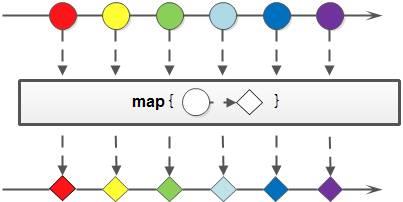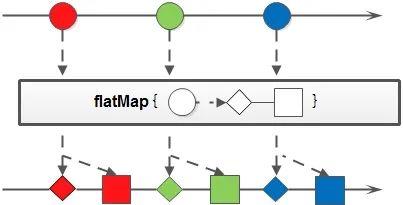Java 8 集合 Stream
Posted teletian
tags:
篇首语:本文由小常识网(cha138.com)小编为大家整理,主要介绍了Java 8 集合 Stream相关的知识,希望对你有一定的参考价值。
Java 8 是一个成功的版本,新增的内容很实用。比如大家熟悉的 lamda 表达式,集合的 Stream,等等。
本文讲讲 Stream 的使用。
Stream 是什么?
Stream 将要处理的集合看做流,然后方便的对流做操作,比如筛选,排序等等。
Stream 的操作可以分为两大类:
- 中间操作。就是操作完还是返回一个流,还可以继续做其他操作。
- 终端操作。就是结束流,流结束之后就不可以再操作了,会返回一个值或者一个新的集合。
Stream 有以下特征:
- 不改变源数据,会生成一个新的数据。
- 具有延迟执行特性,只有调用终端操作时,中间操作才会执行。
中间操作有:
- filter:筛选
- map/flatMap:映射
- sorted:排序
- distinct:去重
- limit:取前 n 个元素
- skip:跳过前 n 个元素
- …
终端操作有:
- collect:收集
- foreach:遍历
- findFirst/findAny:获取单个元素
- anyMatch:判断是否有满足条件的元素
- reduce:归约
- max、min、count:统计
- …
创建 Stream
- 通过集合的 stream() 或者 parallelStream() 方法创建
List<String> list = Arrays.asList("a", "b", "c");
// 创建一个顺序流
Stream<String> stream = list.stream();
// 创建一个并行流
Stream<String> parallelStream = list.parallelStream();
stream() 创建的是顺序流,由主线程按顺序对流执行操作。
parallelStream() 创建的是并行流,如果对顺序没有要求,可以使用它以多线程并行执行。数据量比较大的时候并行流可以明显提高效率。
- 使用 java.util.Arrays.stream(T[] array) 方法用数组创建流
int[] array=1,2,3,4,5;
IntStream stream = Arrays.stream(array);
- 使用 Stream 的静态方法:of()、iterate()、generate()
Stream<Integer> stream = Stream.of(1, 2, 3, 4, 5, 6);
Stream<Integer> stream2 = Stream.iterate(0, (x) -> x + 3).limit(4);
Stream<Double> stream3 = Stream.generate(Math::random).limit(3);
中间操作
filter
传入规则,筛选出符合要求的元素。

例子1(筛选出大于 3 的元素)
Arrays.asList(1, 2, 3, 4, 5).stream()
.filter(x -> x > 3)
.forEach(System.out::println);
结果:
4
5
例子2(筛选出年龄大于 20 的人的姓名)
List<Person> personList = new ArrayList<Person>();
personList.add(new Person("Jack", 10, "男"));
personList.add(new Person("Rose", 15, "女"));
personList.add(new Person("Tom", 20, "男"));
personList.add(new Person("Lucy", 25, "女"));
personList.add(new Person("Lily", 39, "女"));
personList.stream()
.filter(person -> person.getAge() > 20)
.map(Person::getName)
.forEach(System.out::println);
结果:
Lucy
Lily
map、flatMap
用于映射。
-
map:接收一个函数作为参数,按照一定的规则将元素映射为一个新的元素。

-
flatMap:接收一个函数作为参数,按照一定的规则将每个元素映射为一个新的流,然后把所有流连接成一个流。

例子1(将每个数映射为它的平方)
Arrays.asList(1, 2, 3).stream()
.map(i -> i*i)
.forEach(System.out::println);
结果
1
4
9
例子2(将筛选出的年龄大于 20 的 Person 对象映射为 name 属性)
List<Person> personList = new ArrayList<Person>();
personList.add(new Person("Jack", 10, "男"));
personList.add(new Person("Rose", 15, "女"));
personList.add(new Person("Tom", 20, "男"));
personList.add(new Person("Lucy", 25, "女"));
personList.add(new Person("Lily", 39, "女"));
personList.stream()
.filter(person -> person.getAge() > 20)
.map(Person::getName)
.forEach(System.out::println);
结果:
Lucy
Lily
例子3(将每个元素转化为一个流,然后合并)
List<String> newList = Arrays.asList("a,b,c", "d,e,f,g").stream()
.flatMap(s -> Arrays.stream(s.split(",")))
.collect(Collectors.toList());
System.out.println(newList);
结果:
[a, b, c, d, e, f, g]
sorted
排序。
例子1:
List<Integer> sortedList = Arrays.asList(4, 7, 3, 9, 1, 5).stream()
.sorted(Integer::compareTo)
.collect(Collectors.toList());
System.out.println(sortedList);
sortedList = Arrays.asList(4, 7, 3, 9, 1, 5).stream()
.sorted() // 默认升序
.collect(Collectors.toList());
System.out.println(sortedList);
结果:
[1, 3, 4, 5, 7, 9]
[1, 3, 4, 5, 7, 9]
例子2:
List<Person> personList = new ArrayList<Person>();
personList.add(new Person("Lucy", 25, "女", 2));
personList.add(new Person("Rose", 15, "女", 1));
personList.add(new Person("Jack", 10, "男", 1));
personList.add(new Person("Tom", 20, "男", 2));
personList.add(new Person("Tony", 35, "男", 3));
personList.add(new Person("Lily", 30, "女", 3));
// 按年龄排序(升序)
List<String> nameSortedByAge = personList.stream()
.sorted(Comparator.comparing(Person::getAge))
.map(Person::getName)
.collect(Collectors.toList());
System.out.println(nameSortedByAge);
// 按年龄排序(倒序,加 reversed)
nameSortedByAge = personList.stream()
.sorted(Comparator.comparing(Person::getAge).reversed())
.map(Person::getName)
.collect(Collectors.toList());
System.out.println(nameSortedByAge);
// 先按性别再按年龄排序
nameSortedByAge = personList.stream()
.sorted(Comparator.comparing(Person::getSex).thenComparing(Person::getAge))
.map(Person::getName)
.collect(Collectors.toList());
System.out.println(nameSortedByAge);
// 先按性别再按年龄自定义排序(倒序)
nameSortedByAge = personList.stream()
.sorted((p1, p2) ->
if (p1.getSex().equals(p2.getSex()))
return p2.getAge() - p1.getAge();
else
return p2.getSex().compareTo(p1.getSex());
)
.map(Person::getName)
.collect(Collectors.toList());
System.out.println(nameSortedByAge);
结果:
[Jack, Rose, Tom, Lucy, Lily, Tony]
[Tony, Lily, Lucy, Tom, Rose, Jack]
[Rose, Lucy, Lily, Jack, Tom, Tony]
[Tony, Tom, Jack, Lily, Lucy, Rose]
distinct
去重。
例子1:
String[] arr1 = "a", "b", "c", "d" ;
String[] arr2 = "d", "e", "f", "g" ;
List<String> newList = Stream.concat(Stream.of(arr1), Stream.of(arr2))
.distinct()
.collect(Collectors.toList());
System.out.println(newList);
结果:
[a, b, c, d, e, f, g]
例子2:
对象去重
List<Person> personList = new ArrayList<Person>();
personList.add(new Person(1001, "Lucy", 25, "女", 2));
personList.add(new Person(1001, "Lucy", 25, "女", 2));
personList.add(new Person(1002,"Rose", 15, "女", 1));
personList.add(new Person(1003,"Jack", 10, "男", 1));
List<String> names = personList.stream()
.filter(distinctByKey(Person::getId))
.map(Person::getName)
.collect(Collectors.toList());
System.out.println(names);
static <T> Predicate<T> distinctByKey(Function<? super T, ?> keyExtractor)
Map<Object, Boolean> seen = new ConcurrentHashMap<>();
return t -> seen.putIfAbsent(keyExtractor.apply(t), Boolean.TRUE) == null;
结果:
[Lucy, Rose, Jack]
limit
限制从集合中取前 n 位
List<Integer> limitList = Stream.iterate(1, x -> x + 2)
.limit(10)
.collect(Collectors.toList());
System.out.println(limitList);
结果:
[1, 3, 5, 7, 9, 11, 13, 15, 17, 19]
skip
跳过前 n 位
List<Integer> limitList = Stream.iterate(1, x -> x + 2)
.skip(1)
.limit(10)
.collect(Collectors.toList());
System.out.println(limitList);
结果:
[3, 5, 7, 9, 11, 13, 15, 17, 19, 21]
终端操作
forEach
Arrays.asList(1, 2, 3, 4, 5).stream()
.forEach(System.out::println);
结果:
1
2
3
4
5
findFirst
System.out.println(Arrays.asList(1, 2, 3, 4, 5).stream()
.filter(x -> x > 3)
.findFirst()
.get());
结果:
4
findAny
获取任意一个
// findAny 获取任意适用于并行流 parallelStream
System.out.println(Arrays.asList(1, 2, 3, 4, 5).parallelStream()
.filter(x -> x > 3)
.findAny()
.get());
结果:
4 或者 5
anyMatch
是否有满足条件的元素
System.out.println(Arrays.asList(1, 2, 3, 4, 5).stream()
.anyMatch(x -> x > 3));
reduce
归纳。也称缩减,顾名思义,是把一个流缩减成一个值,用与集合求和、求乘积、求最值等。
求和:
List<Integer> list = Arrays.asList(1, 2, 3, 4, 5,